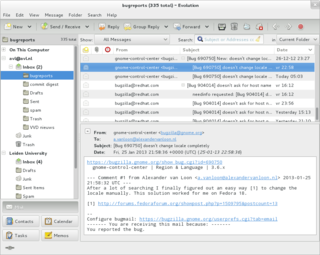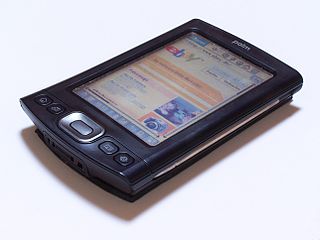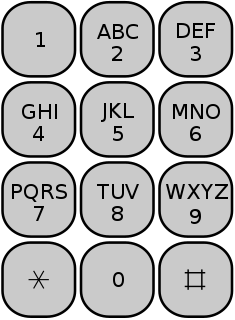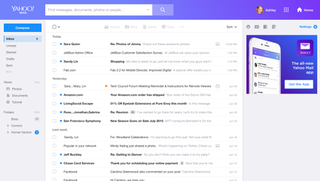
Electronic mail is a method of exchanging messages ("mail") between people using electronic devices. Invented by Ray Tomlinson, email first entered limited use in the 1960s and by the mid-1970s had taken the form now recognized as email. Email operates across computer networks, which today is primarily the Internet. Some early email systems required the author and the recipient to both be online at the same time, in common with instant messaging. Today's email systems are based on a store-and-forward model. Email servers accept, forward, deliver, and store messages. Neither the users nor their computers are required to be online simultaneously; they need to connect only briefly, typically to a mail server or a webmail interface for as long as it takes to send or receive messages.
In computing, the Post Office Protocol (POP) is an application-layer Internet standard protocol used by e-mail clients to retrieve e-mail from a mail server.
The Simple Mail Transfer Protocol (SMTP) is a communication protocol for electronic mail transmission. As an Internet standard, SMTP was first defined in 1982 by RFC 821, and updated in 2008 by RFC 5321 to Extended SMTP additions, which is the protocol variety in widespread use today. Mail servers and other message transfer agents use SMTP to send and receive mail messages. Proprietary systems such as Microsoft Exchange and IBM Notes and webmail systems such as Outlook.com, Gmail and Yahoo! Mail may use non-standard protocols internally, but all use SMTP when sending to or receiving email from outside their own systems. SMTP servers commonly use the Transmission Control Protocol on port number 25.

An email client, email reader or more formally mail user agent (MUA) is a computer program used to access and manage a user's email.

Extensible Messaging and Presence Protocol (XMPP) is a communication protocol for message-oriented middleware based on XML. It enables the near-real-time exchange of structured yet extensible data between any two or more network entities. Originally named Jabber, the protocol was developed by the homonym open-source community in 1999 for near real-time instant messaging (IM), presence information, and contact list maintenance. Designed to be extensible, the protocol has been used also for publish-subscribe systems, signalling for VoIP, video, file transfer, gaming, the Internet of Things (IoT) applications such as the smart grid, and social networking services.
Mail is an email client included by Apple Inc. with its operating systems macOS, iOS and watchOS. Mail grew out of NeXTMail, which was originally developed by NeXT as part of its NeXTSTEP operating system, after Apple's acquisition of NeXT in 1997.
Microsoft Exchange Server is a mail server and calendaring server developed by Microsoft. It runs exclusively on Windows Server operating systems.
Calendaring Extensions to WebDAV, or CalDAV, is an Internet standard allowing a client to access scheduling information on a remote server. It extends WebDAV specification and uses iCalendar format for the data. The access protocol is defined by RFC 4791. It allows multiple client access to the same information thus allowing cooperative planning and information sharing. Many server and client applications support the protocol. Extensions to CalDAV for automated scheduling are also standardized, as RFC 6638.
Push notifications are small messages that can reach audiences anywhere and anytime. There’s a difference between pop-ups and push notifications. Pop-ups appear only when audiences are on the site they belong to. Push messages are independent of sites. They are associated with web browsers and apps.
Sieve is a programming language that can be used for email filtering. It owes its creation to the CMU Cyrus Project, creators of Cyrus IMAP server.
Push email is an email system that provides an always-on capability, in which new email is actively transferred (pushed) as it arrives by the mail delivery agent (MDA) to the mail user agent (MUA), also called the email client. Email clients include smartphones and, less strictly, IMAP personal computer mail applications.
Opportunistic TLS refers to extensions in plain text communication protocols, which offer a way to upgrade a plain text connection to an encrypted connection instead of using a separate port for encrypted communication. Several protocols use a command named "STARTTLS" for this purpose. It is primarily intended as a countermeasure to passive monitoring.

The HTC P4350 is a Pocket PC smartphone manufactured by High Tech Computer Corporation (HTC) of Taiwan. It is also known as the HTC Herald, T-Mobile Wing, and XDA Terra. An updated model running Windows Mobile 6, the HTC P4351, has been sold as the HTC Atlas. It features a right-side QWERTY slide and runs the Windows Mobile 6.0/6.1 Professional Edition operating system.
Z-Push is a FOSS implementation of the Microsoft Exchange ActiveSync protocol which is used to synchronize email, personal contacts and other items between a central server and a mobile device. Note the difference between this protocol, and an earlier protocol named Microsoft ActiveSync.
An email box is the destination to which electronic mail messages are delivered. It is the equivalent of a letter box in the postal system.

Barry Leiba is a computer scientist and software researcher. He retired from IBM's Thomas J. Watson Research Center in Hawthorne, New York in February 2009, and now works for Huawei Technologies as a Standards Manager. His work has focused for many years on electronic mail and anti-spam technology, on mobile computing, and on Internet standards.
Exchange ActiveSync is a proprietary protocol designed for the synchronization of email, contacts, calendar, tasks, and notes from a messaging server to a smartphone or other mobile devices. The protocol also provides mobile device management and policy controls. The protocol is based on XML. The mobile device communicates over HTTP or HTTPS.
A mailbox provider, mail service provider or email service provider is a provider of email hosting. It implements email servers to send, receive, accept, and store email for other organizations or end users, on their behalf.











